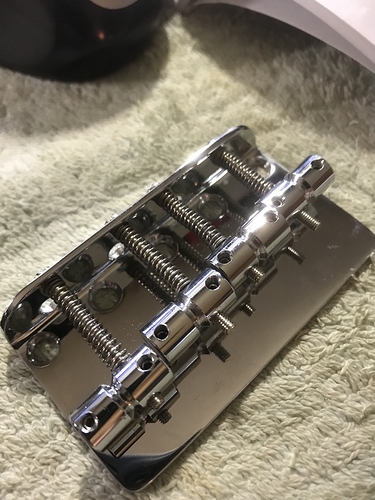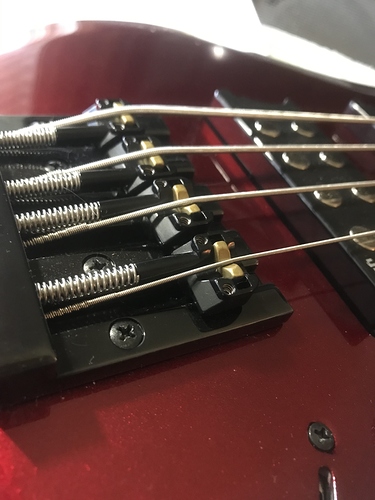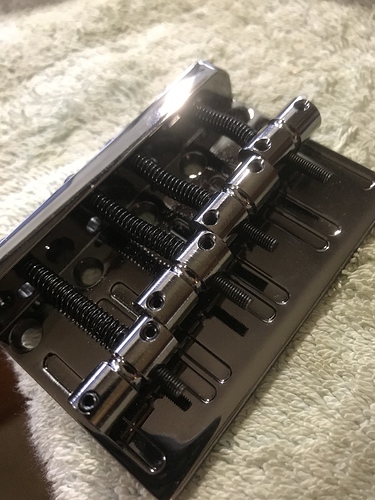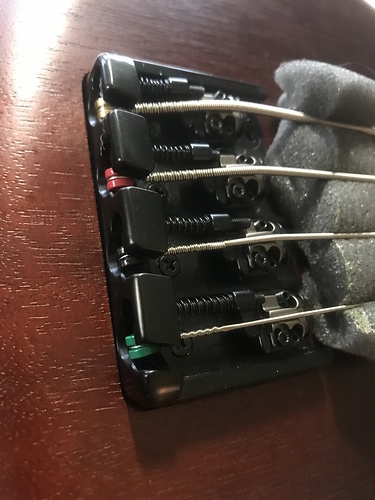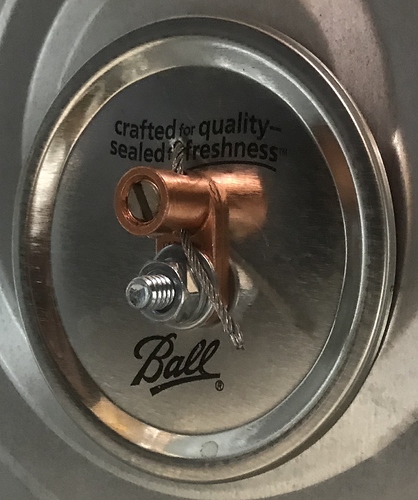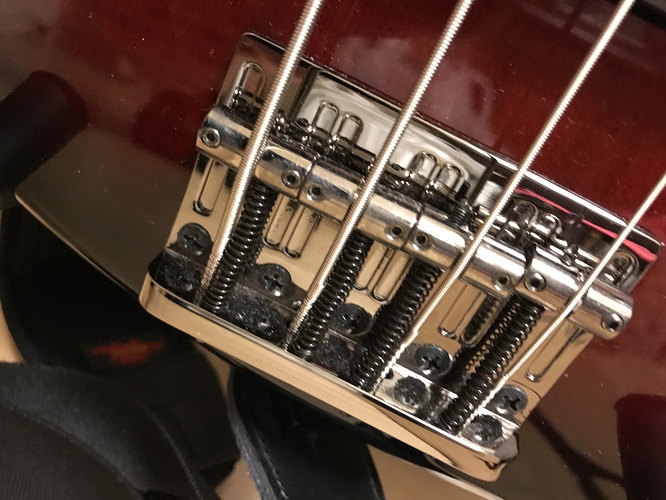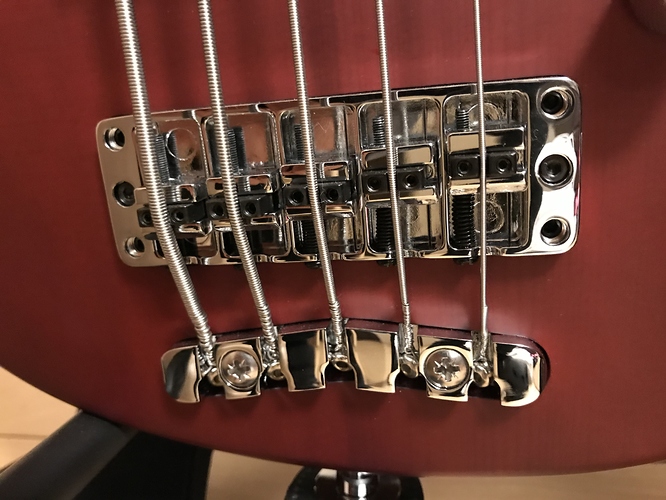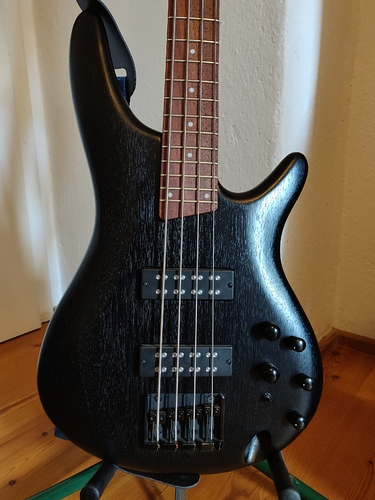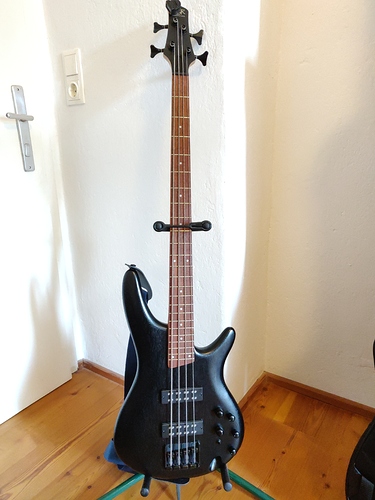quote
“The single-pickup Huntington I model projects a warm, balanced sound with a passive tone control that acts as an “old-school” knob, taming the highs and drawing the bass deeper back into the mix. A piezo-equipped bridge option, activated via toggle switch, enables acoustic bass sounds as well as enhanced attack for pick playing and slap. When the piezo pickups are activated, the tone knob allows the player to adjust the character of the piezo sound”
very nice bass by the way…
Hey Pete that looks like the exact same bridge but in black.
Well spotted!!
Yeah, I thought they were similar, but when I looked closely at the photo I noticed even the stippled effect on the base - just covered a bit with paint on mine. I think it’s the best bridge I have on any of my basses, and it’s what made me think they’re the way to go. Solid through all adjustments, unlike the normal budget bridge that I think is causing a slight problem with my TRBX (“G string not quite right somehow”).
I hadn’t heard of Supro until you posted about them, but this weekend I got a newsletter from Bass Direct about them.
Does your TRBX not have a stock Yamaha bridge? Maybe post a pic?
I have to agree. It’s certainly the best bridge on any of my basses.
It’s an old American name from the 50’s and 60’s that has been resurrected. It was the budget brand of National (like Epiphone was to Gibson) They used to make cheapo catalogue type guitars, but the pickups were always highly regarded. The pickups in the modern Supro’s are copies of the original ones.
As far as I know it is the stock bridge, it’s just not as solid as the one on the Supro and Bird. When I was looking closely because of a slightly odd sounding G string, I noticed that the saddle wasn’t properly bedded in the track, but it won’t quite adjust with the string tensioned. It’s nothing major, but talk of the solid bridges got me thinking.
slacken the string off then . . .
It’s generally tough and not necessarily a good idea to try and reposition saddles with the strings tensioned. If you loosen the strings does it properly seat in the slot?
Haven’t had any issues with the bridge on either of my TRBXs, which is why I was asking…
exactly ![]()
I would think that the stock bridge on the TRBX504 would be a pretty well constructed bridge, but since I’ve never seen on, I wouldn’t be one to offer any information…
However, through your comparison with the Supro and T-Bird, could it be what you are referencing is either the ‘contact’ or the ‘mass’ of the bridge? Having replaced several bridges on most all of my six string and four string instruments, ‘full contact’, and many ‘high mass’ bridges do appear to be more ‘solid’ in appearance when compared to their basic barrel and screw type contact counterparts. See photo below of the stock TRBX174EW barrel and screw bridge.
One of the main purposes of a bridge is to provide a means of adjusting action and intonation. Bridges are really nothing more than a barrel; with a string groove and adjustment screws for intonation (string length) and adjustment screws for string height (action). String tone and sustain (vibration) is transferred to the body of the instrument through bridge contact to the body by either string through body or string on bridges that are mechanically attached to the body of the instrument. Pretty much stuff we all already kinda know already anyway…
Then again, comparing different types and styles of bridges,… as in it is life,… looks can be a bit deceiving…
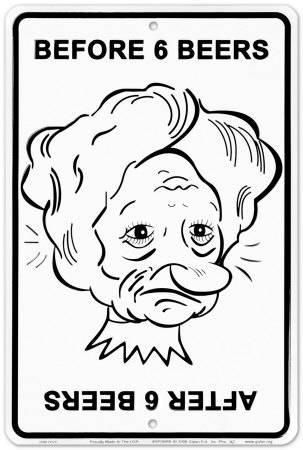
Some ‘High Mass’ bridges may look to be full contact at first glance. For instance, the Babitz bridge that I installed on the TRBX174 is a ‘Full Contact’ bridge. (see photo)
With this full contact bridge, contact surfaces from the string to the saddle and to the bridge base (and finally to the bass body) are at or near 100% since the adjustments for the string saddle and the string angle to the fretboard are both “cam” operated. Intonation (string length) is no different than any other bridge. Although this bridge cost half of what the entire 174 cost me, it does provide a very warm sustained tone, and makes the 174 sound like a $500 bass instead of a $200 bass and with good old round-wounds, works great for me when I play those old country ballads and bluegrass songs.
Now compare that with the Hipshot KickAss bridge that I installed on the Yamaha TRBX304, replacing it’s original barrel bridge…
This particular bridge is a ‘High Mass’ bridge that also ‘looks’ pretty solid compared to it’s stock counterpart which is nothing more that an upgraded version of the stock TRBX174 bridge… The KickAss bridge however does allow for optional ‘string spacing’ with strings saddled inside of brass saddles (more adjustments). Additionally, a little more contact ‘may’ be realized with each saddle riding inside of a separate track for each string. This bridge (IMHO) works well with the 2 double coil pickups and half round strings to give me the deep smooth tones that I like when playing my '70’s rock songs…
Now compared to the ‘stock’ bridge that I have on the Ibanez SR500E, you can see that it came stock with pretty much the same bridge as the Hipshot KickAss…
Not sure as if I’ll change this bridge out anytime in the near future since it provides plenty of good tone and sustain… Basically, the only reason I did replace the bridges on both my 174 and 304 Yammy’s was for no other reason then I’m not a fan of barrel type bridges (even replace the original on my '52 Tele with a full contact Babitz). For me, the tonal qualities that I get from both High Mass and Full Contact bridges is (IMO), richer, smoother, and deeper when I combine just the right combination of string type and size given the genre and style of music I play. There have even been times when I’ve changed a bridge back to stock to see if I could get a specific tone that I was looking for in a song. (Ive done this before on my '52 Tele six string in order to get a '60’s jazz/blues tone)
I guess it’s all just a personal thing, we all hear and see things differently… making looks a personal thing too… just don’t be “deceived”…![]()
![]()
Sorry for the long ass post, maybe I should get back to cleaning up my work shop…![]()
![]()
You forgot to show the bridge for your one string bass. 
@JT - How’s this??..
That post is awesome, thanks Lanny.
The 504 and 604 have a similar (probably identical) bridge to the 304:
I am not going to swap it out as I have no problems with it (and it is nice and light), but that hipshot or the one on the Ibby (probably a Goto?) definitely look more substantial.
My Warwick has an interesting two-piece bridge that is pretty substantial:
That one adjusts in many different ways - individual string height and spacing, raising or lowering each of the four corners of the whole bridge, etc. Meanwhile the tonal transmission is in the fixed tailpiece.
Wait…that Supro is a Short-scale… OH MY…just when I thought I didnt want another Bass yet… Been thinking of getting new tuners, bridge, and electronics on my Ibanez GSRM-20 Mikro… now… hummm The Supro…
OMG!! I’m LOVING this bridge @howard! I can only imagine the sound one could achieve with a bit of sponge under the strings between the two piece bridge… So cool!!
Apparently standard on all Warwicks. Pretty ingenious, agreed 
@Lanny Great post. Also, nothing guarantees quality quite like a Ball bridge.
@howard Yep. Those two piece Warwick bridges are really cool looking.
Talk about amazing customer service… I discovered my Warwick has a stripped lock screw on one of the bridge saddles, so I emailed them to see if they had a local parts distributor where I could just pick up a new saddle (since I don’t want to get a warranty service just for a stripped screw.) I got a personal reply back from Warwick within an hour… from the co-founder and current COO.
Ok that’s excellent, even for someone spoiled by Japanese customer service.
Holy crap! That is some impressive customer service.
